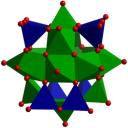Yahoo Answers is shutting down on May 4th, 2021 (Eastern Time) and beginning April 20th, 2021 (Eastern Time) the Yahoo Answers website will be in read-only mode. There will be no changes to other Yahoo properties or services, or your Yahoo account. You can find more information about the Yahoo Answers shutdown and how to download your data on this help page.
Trending News
Why don't dislocations go away?
[10 points 5 green stars and 5 blue stars]
There is a very long rod cut of single crystal of cubic material along [001] direction at zero temperature.
The material is made of symmetric tooth picks
http://en.wikipedia.org/wiki/File:Toothpick_s.jpg
(that is, atoms are tooth picks) fixed at cubically arranged nodes, and tooth picks can freely rotate around their fixed centers.
Every tooth pick interacts with its 6 neighbors, and energy of pair-wise interaction is
E = +sin²(φ),
where φ is angle between the tooth picks. Such interaction naturally tends to align nearby tooth picks in parallel.
Radius of the rod is 1,000,000,000 unit cells.
Estimate (estimate only!) energy of ground state per layer of atoms when boundary conditions on the lateral surface are:
a) all tooth picks on the surface are held at right angle to the surface
b) all tooth picks on the surface are bi-sectors between positive-x direction and outward normal to the surface.
Tooth picks can rotate in three dimensional space
FGS:
*** It is clear on its face that b will
*** have much less energy.
Exactly. The whole point of this problem is to show that opposite is true, and how comes it's true.
2 Answers
- TimothyLv 61 decade agoFavorite Answer
Do any of the people who starred this question really understand the "structure" of the "toothpick crystal" described here?
I know a lot of crystal structures of solids, have a fair amount of experience with solid state chemistry, and I can't think of any solids that end up in any kind of cubic space group while local interaction energy favors parallel alignment of cylindrical molecules. Indeed, the statement, "Every tooth pick interacts with its 6 neighbors" puts a strong constraint on the local environment of the toothpicks. Why only 6? That sounds like we are to assume a hexagonal packing of toothpicks in 2-D layers – with cylindrical toothpick "molecules", I'd like to see how can simultanously be in its ground state, and be cubic in symmetry. (And to someone who knows anything about crystals, the word "cubic" is a description of symmetry.) Frankly, I can't tell what the hell this question means.
EDIT: I'm guessing this is what you meant here: toothpicks are positioned such that their centers reside at points with coordinates (uℓ,vℓ,wℓ), u,v,w = integers, length of the toothpick = ℓ – δ (ℓ ≫ δ). The word "cubic" has nothing to do with symmetry in your use of the term, does it?
EDIT2: First Grade and I seem to have a different interpretation of what the word "layer" refers to – and I am by no means certain my interpretation is correct (hence my whining in the above!). Taking the toothpick axis to be "z", I thought it referred to each layer along the z-direction, because one can take adjacent layers to have parallel toothpick alignments. So, its a 2-D problem. This problem has been nagging at me, but I never got time to go after it. Here was my approach on a):
I think the minimum energy alignment has the toothpicks in the center upright (along z), and they flatten out as one progresses radially outward. (See attached figure.) The toothpick axes are therefore described as a vector field: v = (1/√(1 + f²(r)))[cosθ, sinθ, f(r)] where f(r) → ∞ as r → 0 and f(r) → 0 as r → 10⁹. Each toothpick is involved in four pairwise interactions with neighbors, but f(r) varies slowly enough that the interaction will be locally symmetric wrt inversion. The pairwise interaction energies are |v(x,y)×v(x±1,y)|² and |v(x,y)×v(x,y±1)|². Those are summed (not multiplied by two, otherwise you double-count); that gets multiplied by 2πr, and then one integrates r from 0 to 10⁹. Ideally, f(r) is determined variationally to minimize the energy, but since it is weighted by 2πr the falloff wrt r should reflect that. (b) is tougher because the symmetry is lower!
Hope this makes some sense.
- 1 decade ago
I was hoping someone more knowledgeable would go for this. I would have liked to see their work.
It is clear on its face that b will have much less energy.
Case 1
Ω = 4π/N = 2π(1-cos(φ))
N = number in outer layer.
2/N = (1-cos(φ))
φ = acos(1-2/N)
E= +sin²(Ï)
Σ E = 3N *sin²( acos(1-2/N))
Case 2
Ω = 2π/N = 2π(1-cos(φ))
N = number in outer layer.
1/N = (1-cos(φ))
φ = acos(1-1/N)
E= +sin²(Ï)
Σ E = 3N *sin²( acos(1-1/N)) ...
For small angles, the acos(1-1/N) will be smaller by 1/√2 therefore Σ E will be 1/2
Note: in doing this I presumed that the toothpicks would have the same relationship with their bedfellows, i.e., angle φ, as in the upper case however, you could argue that the 3N factor should be reduced to 1 N on the flat side to reflect the flat surface. Don't know enough about crystals.




